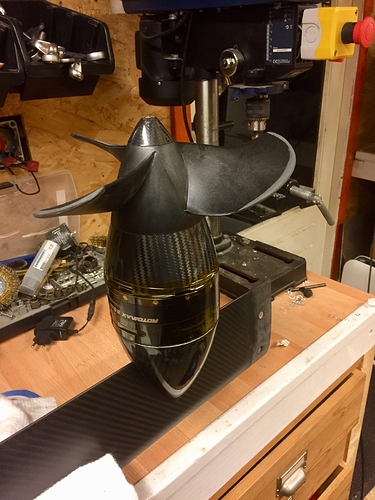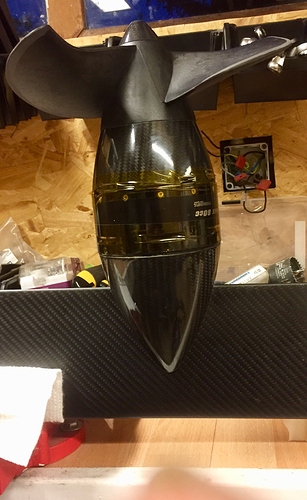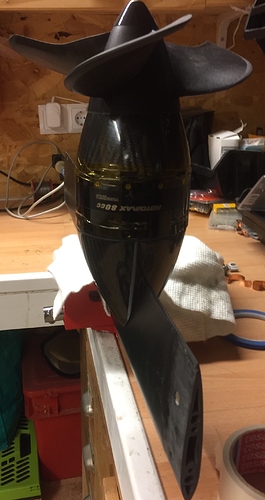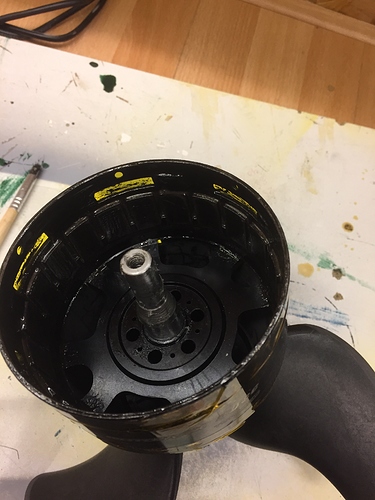Hi
it is a lot of work to extract the correct parts, because i made such a lot of modifications in the design process. I do not want to release the complete history, it is a mess. Additionally i adapted some parts by hand after printing. Would it help if i release some stl files i exported for printing?
There are big uncertaincies in my graph. The original measuring data is instable, and the assumptions i made are optimistic. I used my measuring point for 13.4km/h at 1700W and adapted the battery power graph to be similar to the power demand graph, than scaled it by factor 2.4. Very simple approach.
Time to get some books.
STL files are also very helpful, since I have the same motor as yours and I would try different props with this setup based on your STL files.
I ordered two props now, which i will cut down to 140mm:
Yamaha Outboard 4hp 5hp Engine Part 7 1/2 X 7-BA
YAMAHA original Propeller 7 1/2 X8 BA
I hope i can build an adapter to swap between these.
I cannot recommend to use a smaller diameter in conjunction with 6384 100Kv PG, because the throughput might be too low. Also props with less blade area, e.g. 2 blade props will propably not work.
I will try smaller props with sk3-149kv motor. (Probably 5 or 6 inch prop). For 100kv 140-150mm this is the way to go. I saw in the forum that airprop has shown also good results in the water so it makes sense to try it
Its not said, that we build the best setup. Please contribute.
Hi,
do you try to test insulation in water like powerglider indicates above but with the megohmeter ?
with a regular multimeter i get OL, but with the the megohmeter i get 0.something Mohm…
I ran the motor in water anyway, and it looked fine 
I took some measurement with 250V insulation tester in saltwater. For the epoxied stator alone i got OL, for the assembled motor including the solderings of the motor cables i got something less, hard to reproduce, minimum was around 100kOhm. I covered the soldering with Plastik 70 Kontaktchemie, sometimes i put a fat blob of MS Polymer around it, but made the experience it does not stick perfectly to the wires. It can help to increase resistance and to mechanically protect the underlying Plastik 70 furthermore. Theoretical a value of 10kOhms is sufficient, as it would limit the current to I=U/R=50V/10000=5mA, which is noticeable but not harmful. Such leakages can be caused by very small cracks where the water contact surface is very small. All these tests should be done in saltwater, i just solve salt in the water, so it tastes really salty.
thanks, i guess i’ll keep it as is then 
the water proofing i did was:
STATOR:
Remove the tubing around the wires
Cut the wires to length and solder the connectors
Cover the wires with some liquid tape between the connectors and the windings
Then apply a few layers of epoxy on the winding (the epoxy i use to make surfboards) end Thickness was no more than 1mm i think.
Then i sanded to get the outside diameter cleaned up, almost back to the metal.
Finally a couple coat of spray urethane to really seal everything (very thin)
after that i protected the wires coming out with adhesive lined shrink tubing… that seems pretty watertight. i’m using the same shrink tubing to cover and hold the connection to the wires going up the mast.
ROTOR:
i just sanded the outside smooth and cleaned the inside with acetone. After that, it received a few layer of “appliance epoxy” … just because it was written waterproof and the can 
I replace the bearings with some SST ones, i have come completely open, some 2RS. for now i’m using the open as they are easier to clean / lubricate
Finally i replaced the shaft with a titanium one.
I waterproofed my cables by smearing silicone on the solder joint. Then I put a heat shrink tube over it and let it squeeze out the silicone. After it was cured, I added another layer of silicone and heat shrink so it’s overlapping.
Finally found some time to make a little progress. I covered all the iron and magnets with epoxy hope this is enough. Looks like a lot of people trying to run a outrunner direct underwater. Any good results yet?
What motor & housing is that?
Well, i reached 16.5km/h with a cut down 7.5X8" Yamaha propeller on my windsurfboard with a battery power of 2.1kW using the 6384 PG 100Kv with 12s and a VESC 4.12 with modified cooling with heat pipes and forced air.
At 16km/h it is gliding, becomes little instable and the turnes are tighter.
I have the possibility to swap props now without disassembling the motor and another prop with 7.5X7" is on its way.
Were the STL files helpful?
Does anyone else need them, i can provide them per mail?
Yes, that would be really helpful, thanks!
Btw, has anybody the Solidworks files from the user tunnelvision? He uploaded it on Dropbox but the link expired.
Hi powerglider, still tuning the 3d printer and waiting for few props. Will update once will run in water. Great news. I think with a foil it will get much faster.
Do you know your current at start and 16.5km/h?
The motor current i can actually only measure with my computer and the VESC connected to it. I am not sure, if there was a motor current limitation with the 8" pitch prop. I am very sure there was no current limit with the 5" pitch prop. So i wait for the 7" to test. In the meanwhile i am building a 5 blade guide vane from PLA. Additionally i am rebuilding my battery holder which was made of carbon now with glass fiber. The carbon is highly conductive and i already had two small incidents leading to small fire. Luckily without much damage. This time i am using GFK plate and nylon threads, no more steel rods. There are such a lot of cables everywhere, one small plug on the Tf02 was shorted when i turned the whole board upside down to mount the old drive system, when the battery holder out of carbon was pressing right in the middle between the contacts for B+ and B-.
I appreciate that you share so many details. This really helps out others to not make the same mistakes.
Where are you getting this equation from? Are you converting 5.25" in your computations? RPM/V = Kv? V = volts? Kv = ?




